
A close up of the boulder brain coral. The Boulder Brain Coral (Colpophyllia natans) is a scleractinian (hard) coral with a skeleton of limestone. In this species, the corallites of each polyp are joined to create the valleys and ridges seen here, which produce a pattern similar to that of the brain.
Photographer: Ramon Roach
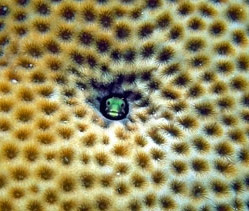
A Blenny peeks out from a starlet coral. Blennies (Family Clinidae) are usually difficult to spot as they change colours to blend in with their backgrounds, and usually only their heads are visible. Each individual corallite of the starlet coral (Siderastrea sp) can be clearly seen.
Photographer: Leigh Weatherhead
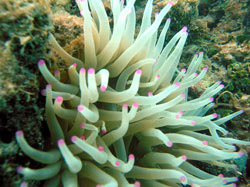
The Giant Anemone waves its tentacles. Anemones belong to the same Class as the corals, and like them, their tentacles contain stinging cells called nematocysts. The Giant Anemone (Condylactis gigantean) is the largest of the Caribbean anemones. Contact with them tends to result in mild irritation of the skin.
Photographer: Ramon Roach
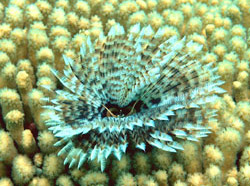
Feather Duster living amongst a colony of Yellow Pencil Coral. The Magnificent Feather Duster (Sabellastarte magnifica) is a sessile (stationary) marine segmented tube worm. The flexible tube, which is composed of glued-together fine sand, is hidden within a colony of Yellow Pencil Coral (Madracis mirabilis). The head of the worm is encircled by featherlike radioles which serve a dual purpose; they act as gills and capture plankton for food.
Photographer: Ramon Roach
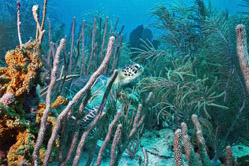
A Green Turtle nestled within a coral reef. The Green Turtle (Chelonia mydas), the largest of all hard shelled sea turtles is listed as threatened in the Caribbean. It is unique in that it is herbivorous, feeding primarily on a diet of algae and sea grass, which gives its fat a greenish hue. Green turtles are observed regularly in our nearshore waters; however their nesting population numbers less than five.
Photographer: Gregory Sealy
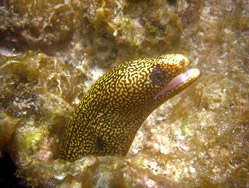
Moray looking out from the reef. The Spotted Moray (Gymnothorax moringa) usually hides in dark holes in the reef during the day. Normally they are not aggressive animals, but when provoked they can inflict painful bites.
Photographer: Renata Goodridge
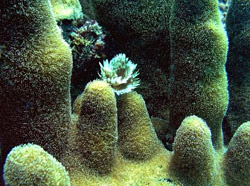
A tube worm lives within a pillar coral colony. The Pillar Coral (Dendrogyra cylindrus) is one of the few hard corals in which the tentacles of the polyps are extended during the daytime, giving the animal a fuzzy appearance.
Photographer: André Miller
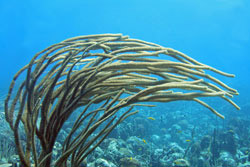
A Sea Rod colony bends in the stiff current. Sea Rods (Plexaurella sp) are corals, but not the reef-building kind. They are called gorgonians and have a central skeleton made of a protein called gorgonin from which they derive their names and their flexibility. All Gorgonians filter the water for the plankton on which they feed.
Photographer: Ramon Roach